AKG C 418 III User Manual

C 418III
Bedienungshinweise . . . . . . . . . . . . . . . . . . S. 2
Bitte vor Inbetriebnahme des Gerätes lesen!
User Instructions . . . . . . . . . . . . . . . . . . . . p. 12
Please read the manual before using the equipment!
Mode d’emploi . . . . . . . . . . . . . . . . . . . . . . p. 22
Veuillez lire cette notice avant d’utiliser le système!
Istruzioni per l’uso . . . . . . . . . . . . . . . . . . . p.32
Prima di utilizzare l’apparecchio, leggere il manuale!
Modo de empleo . . . . . . . . . . . . . . . . . . . . p. 42
Antes de utilizar el equipo, sírvase leer el manual!
Instruções de uso . . . . . . . . . . . . . . . . . . . p. 52
Favor leia este manual antes de usar o equipamento!
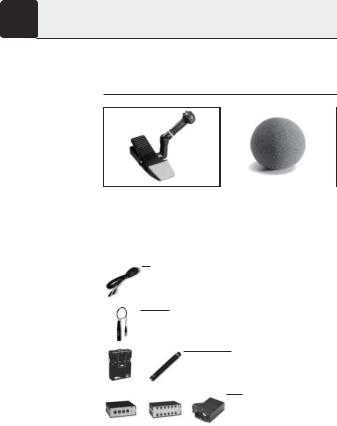
1.1 Sicherheits- Überprüfen Sie bitte, ob das Gerät, an das Sie das hinweis Mikrofon anschließen möchten, den gültigen Sicherheitsbestimmungen entspricht und mit einer
Sicherheitserdung versehen ist.
1.2 Lieferumfang
|
1 C 418III |
|
|
|
1 W 44 |
||||
|
Kontrollieren Sie bitte, ob die Verpackung alle |
||||||||
|
oben angeführten Teile enthält. Falls etwas fehlt, |
||||||||
|
wenden Sie sich bitte an Ihren AKG-Händler. |
||||||||
1.3 Empfohlenes |
|
|
|
|
|
|
|
|
|
|
|
• Mikrofonkabel MK 9/10: 10 m 2-polig |
|||||||
|
|
||||||||
Zubehör |
|
|
|
geschirmtes Kabel mit XLR-Stecker |
|||||
|
|
|
|
|
|
|
|
|
und XLR-Kupplung |
|
|
|
|
• Phantomspeiseadapter MPA III L |
|||||
|
|
|
|
||||||
|
|
|
|
||||||
|
|
|
|
|
|
|
|
• Batteriespeisegeräte |
|
|
|
|
|
|
|
|
|
||
|
|
|
|
|
|
|
|
||
|
|
|
|
|
|
|
|
|
B 29 L, B 15 |
|
|
|
|
|
|
|
|
|
• Phantomspeisege- |
|
|
|
|
|
|
|
|
|
|
|
|
|
|
|
|
|
|
|
räte N 62 E, |
|
|
|
|
|
|
|
|
|
N 66 E, B 18 |
|
|
|
|
|
|
|
|
||
|
|
|
|
|
|
|
|
|
|
1.4 Besondere |
• Robustes Kondensatormikrofon für Instrumen- |
||||||||
Merkmale |
talabnahme auf der Bühne. |
||||||||
|
• Frequenzgang speziell für die Abnahme von |
||||||||
|
Schlaginstrumenten ausgelegt. |
||||||||
2

1 Beschreibung 

•Gummiüberzogener Clip zur stabilen Befestigung am Instrument.
•Mikrofonarm mit Schwenkgelenk zur exakten Ausrichtung des Mikrofons.
•Elastische Lagerung des Wandlersystems zur wirkungsvollen Körperschallunterdrückung.
•Hohe Rückkopplungssicherheit durch frequenzunabhängige hypernierenförmige Richtcharakteristik.
Das C 418III ist ein Kondensator-Miniaturmikrofon |
1.5 Kurz- |
|
mit hypernierenförmiger Richtcharakteristik. Es |
beschreibung |
|
wurde speziell für die Abnahme von Schlaginstru- |
|
|
menten (Snare, Tom-Toms, Roto-Toms) direkt am |
|
|
Instrument entwickelt. |
|
|
Eine Bassabsenkung ab 500 Hz verhindert die |
|
|
Überbetonung der tiefen Frequenzen, die unver- |
|
|
meidlich entsteht, wenn ein Mikrofon sehr nahe |
|
|
am Schlagfell befestigt ist. Eine Anhebung der |
|
|
Empfindlichkeit bei 5 bis 10 kHz sorgt für einen |
|
|
knackigen Sound. |
|
|
Ein robuster, gummiüberzogener Clip erlaubt die |
|
|
sichere Befestigung am Instrument. Der Mikrofon- |
|
|
arm mit Schwenkgelenk ermöglicht eine exakte |
|
|
Ausrichtung des Mikrofons auf das Schlagfell. |
|
|
Durch seine hypernierenförmige, frequenzunab- |
|
|
hängige Richtcharakteristik ist das C 418III beson- |
|
|
ders unempfindlich gegen Rückkopplungen und |
|
|
Übersprechen von benachbarten Instrumenten. |
|
|
Die spezielle elastische Lagerung des Wandlersy- |
|
|
stems sorgt für eine weitgehende Unempfindlich- |
|
|
keit des Mikrofons gegen Körperschall und |
|
|
Schläge mit dem Drumstick. |
|
|
Ein externer Windschutz für die Dämpfung von |
|
|
Windgeräuschen bei Einsatz im Freien ist im Lie- |
|
|
ferumfang enthalten. |
|
|
|
|
|
3
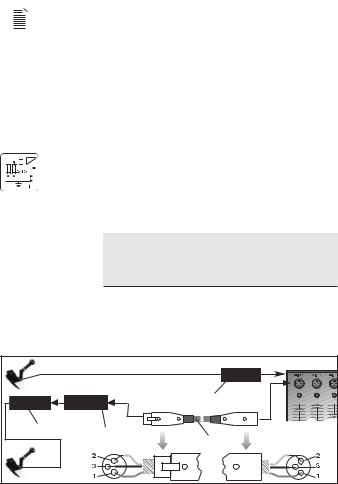
|
|
|
|
|
|
|
|
|
|
|
|
|
1.6 Varianten |
Das C 418III ist in zwei Ausführungen erhältlich: |
|
|
|
|
|
|
|
C 418III PP |
• Mit 3-poligem XLR-Stecker mit eingebautem |
|
|
|
|
|
|
|
Adapter für Universal-Phantomspeisung von 9 |
|
|
|
|
|
|
|
bis 52 V. |
|
|
|
|
|
|
C 418III L |
• Mit verriegelbarem Mini-XLR-Stecker zum An- |
|
|
|
|
|
|
|
schluss an Battteriespeisegerät B 29 L, Phan- |
|
|
|
|
|
|
|
tomspeiseadapter MPA III L oder AKG- |
|
|
|
|
|
|
|
Taschensender. |
|
|
|
|
|
|
|
|
|
|
|
|
|
|
|
|
|
|
|
|
|
|
|
|
|
|
|
|
|
|
|
|
|
|
|
|
|
|
|
|
|
|
|
|
|
|
|
|
2.1 Einleitung Das C 418III PP/C 418III L ist ein Kondensatormikrofon und benötigt daher eine Stromversorgung.
Wichtig! Wenn Sie andere als die von AKG empfohlenen Speisegeräte verwenden, kann das Mikrofon beschädigt werden und erlischt die Garantie.
2.2 C 418III PP 1. Stecken Sie den Phantomspeiseadapter (1) am 2.2.1 Anschluss Mikrofonkabel an einen symmetrischen XLR- an symmetri- Mikrofoneingang mit Phantomspeisung an. sche Eingänge 2. Schalten Sie die Phantomspeisung ein. (Lesen
|
|
XLR |
XLR |
Phantom |
1 |
1 |
2 |
|
|
3 |
|
|
|
Abb. 1: Anschluss an symmetrischen Eingang
4
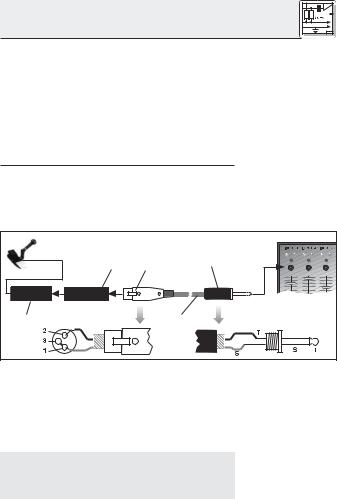
2 Anschluss |
Sie dazu in der Betriebsanleitung des jeweiligen Gerätes nach.)
3.Wenn Ihr Mischpult keine Phantom- Siehe Abb. 1. speisung besitzt, stecken Sie den Phantomspeiseadapter (1) an ein optionales AKG-Phantomspeisegerät (2) (N 62 E, N 66 E,
B 18, B 15) an und verbinden Sie das Phantomspeisegerät mit Hilfe eines XLRKabels (3) (z.B. AKG MK 9/10 - nicht mitgliefert) mit einem symmetrischen Eingang.
Phantomspeisegeräte (2) von AKG können Sie auch |
2.2.2 Anschluss |
|
an einen asymmetrischen Eingang anschließen. |
an asymmetri- |
|
Verwenden Sie dazu |
ein Kabel (3) mit XLR- |
sche Eingänge |
Stecker (weiblich) und |
Mono-Klinkenstecker: |
Siehe Abb. 2. |
|
2 |
4 |
5 |
XLR |
Phantom |
|
|
1 |
|
|
3 |
Abb. 2: Anschluss an asymmetrischen Eingang
1.Verbinden Sie im XLR-Stecker (4) mittels einer Drahtbrücke Stift 1 mit Stift 3 und mit der Abschirmung.
2.Verbinden Sie die innere Ader des Kabels mit Stift 2 des XLR-Steckers (4) und der Spitze des Klinkensteckers (5).
Beachten Sie, dass asymmetrische Kabel Ein- Hinweis: streuungen aus Magnetfeldern (von Netzund Lichtkabeln, Elektromotoren usw.) wie eine An-
tenne aufnehmen können . Bei Kabeln, die län-
5
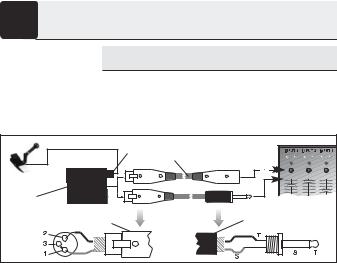
ger als 5 m sind, kann dies zu Brummund ähnlichen Störgeräuschen führen.
2.3C 418III L Mit dem optionalen Batteriespeisegerät B 29 L
2.3.1Anschluss können Sie das Mikrofon an symmetrische oder mittels B 29 L asymmetrische Eingänge ohne Phantomspeisung
Siehe Abb.3. anschliessen.
1 |
3 |
|
|
|
|
B 29 L |
|
|
2 |
|
|
4 |
|
5 |
|
|
|
Abb. 3: Anschluss-Schema mit B 29 L |
|
|
Kabel anstecken: |
1. Stecken Sie den Mini-XLR-Stecker (1) am |
|
|
Mikrofonkabel bis zum Anschlag in eine der |
|
|
beiden Mini-XLR-Buchsen am B 29 L (2). |
|
Kabel abziehen: |
Der Stecker (1) verriegelt sich automatisch. |
|
Zum Abziehen des Kabels drücken Sie auf |
||
|
den Entriegelungsknopf am Mini XLR-Stecker |
|
|
(1) und ziehen Sie den Stecker (1) aus der |
|
Wichtig! |
Buchse heraus. |
|
Um das Kabel nicht zu beschädigen, zie- |
||
Siehe Abb. 3. |
hen Sie niemals am Kabel selbst! |
|
2. Verbinden Sie das B 29 L (2) mit dem |
||
Symmetrischer |
gewünschten Eingang. |
|
• |
Zum Anschluss an einen symmetrischen |
|
Eingang: |
|
Eingang verwenden Sie ein handelsübli- |
Asymmetrischer |
|
ches XLR-Kabel (3). |
Eingang: |
• |
Siehe Kapitel 2.2.2. |
|
|
|
6
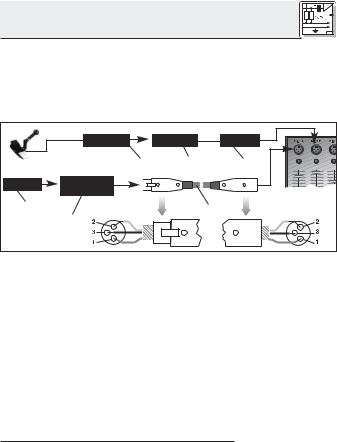
2 Anschluss |
1. Stecken Sie den Mini-XLR-Stecker (1) am |
2.3.2 Anschluss |
Mikrofonkabel bis zum Anschlag in die Mini- |
mittels MPA III L |
XLR-Kupplung (2) am Anschlusskabel des |
Kabel anstecken: |
MPA III L (3). |
Siehe Abb. 4. |
Der Stecker (1) verriegelt sich automatisch. |
Kabel abziehen: |
Siehe Kapitel 2.3.1. |
|
Mini XLR |
Mini XLR |
MPA |
|
1 |
2 |
3 |
MPA |
Phantom |
|
|
3 |
4 |
|
5 |
|
|
|
Abb. 4: Anschluss-Schema mit MPA III L
2.Stecken Sie den MPA III L (3) an einen symmetrischen XLR-Mikrofoneingang mit Phantomspeisung an.
3.Schalten Sie die Phantomspeisung ein. (Lesen Sie dazu in der Betriebsanleitung des jeweiligen Gerätes nach.)
4.Wenn Ihr Mischpult keine Phantom- Siehe Abb. 4. speisung besitzt, stecken Sie den MPA III L
(3)an ein optionales AKG-Phantomspeise-
gerät (4) (N 62 E, N 66 E, B 18, B 15) an und verbinden Sie das Phantomspeisegerät (4) mit Hilfe eines XLR-Kabels (5) (z.B. AKG MK 9/10 - nicht mitgliefert) mit einem symmetrischen Eingang.
Lesen Sie in der Bedienungsanleitung Ihres |
2.3.3 Anschluss an |
|
Taschensenders nach. |
Taschensender |
|
|
|
|
7
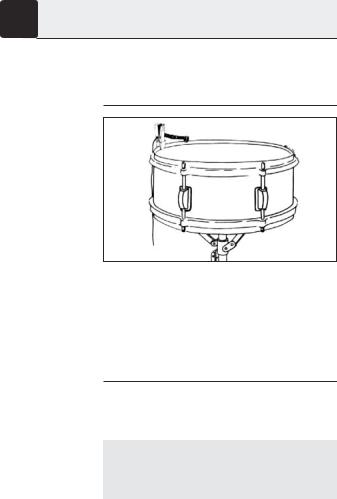
3.1 Einleitung Um den ”richtigen” Sound zu finden, müssen Sie in jedem Fall mit der Mikrofonpositionierung experimentieren. Als Ausgangspunkt dafür sind in den folgenden Kapiteln bewährte Mikrofontechniken beschrieben.
3.2 Snare Drum
Abb. 5: Befestigung des Mikrofons an der Snare Drum
Siehe Abb. 5. 1. Klemmen Sie das Mikrofon am Spannring des Schlagfells an.
2.Positionieren Sie das Mikrofon:
•Wenn Sie das Mikrofon auf den Rand des Schlagfells ausrichten, erhalten Sie einen harten, knackigen Sound.
•Wenn Sie das Mikrofon auf die Mitte des Schlagfells ausrichten, erhalten Sie einen volleren, offeneren Sound.
3.3Tom-Toms, 1. Klemmen Sie das Mikrofon am Spannring des Roto-Toms Schlagfells an und richten Sie es wie in Kapitel
Siehe Abb. 6 und 7. |
3.2 beschrieben aus. |
Hinweis: Durch den speziell entwickelten Frequenzgang des Mikrofons mit einer sanften Bassabsenkung ab 500 Hz bis zu einer maximalen Dämpfung von 12 dB bei 50 Hz wird ein Nachschwingen des Schlagfells kaum hörbar werden. Ei-
8
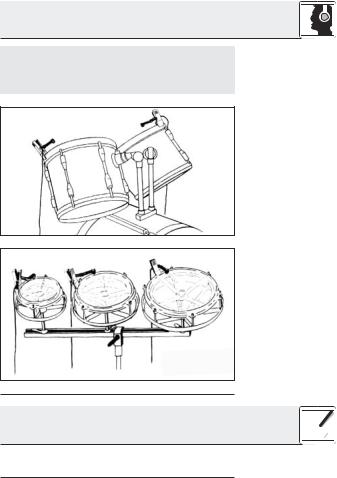
3 Anwendung 

nen besonders trockenen Sound erhalten Sie, wenn Sie ein Papiertaschentuch oder ein Stück Filz mit Klebeband am Rand des Schlagfells befestigen.
Abb. 6: Befestigung des Mikrofons an Tom-Toms
Abb. 7: Befestigung des Mikrofons an Roto-Toms
4 Reinigung 

Reinigen Sie das Gehäuse des Mikrofons mit einem mit Wasser befeuchteten Tuch.
9

|
|
|
|
|
|
|
|
|
|
|
|
|
Fehler |
|
Mögliche Ursache |
|
Abhilfe |
|
|
|
|
|
|
|
Kein Ton: |
1. |
Mischpult und/oder |
1. |
Mischpult und/oder |
|
|
|
Verstärker ausge- |
|
Verstärker ein- |
|
|
|
schaltet. |
|
schalten. |
|
|
2. |
Kanal-Fader oder |
2. |
Kanal-Fader oder |
|
|
|
Summenpegelregler |
|
Summenpegelregler |
|
|
|
am Mischpult oder |
|
am Mischpult oder |
|
|
|
Lautstärkeregler des |
|
Lautstärkeregler des |
|
|
|
Verstärkers steht auf |
|
Verstärkers auf ge- |
|
|
|
Null. |
|
wünschten Pegel |
|
|
|
|
|
einstellen. |
|
|
3. |
Mikrofon nicht an |
3. |
Mikrofon an Misch- |
|
|
|
Mischpult oder |
|
pult oder Verstärker |
|
|
|
Verstärker ange- |
|
anschließen. |
|
|
|
schlossen. |
|
|
|
|
4. |
Kabelstecker nicht |
4. |
Kabelstecker |
|
|
|
richtig angesteckt. |
|
nochmals an- |
|
|
|
|
|
stecken. |
|
|
5. |
Kabel defekt. |
5. |
Kabel überprüfen |
|
|
|
|
|
und falls nötig er- |
|
|
|
|
|
setzen. |
|
|
6. |
Keine Speise- |
6. |
Phantomspeisung |
|
|
|
spannung. |
|
einschalten. |
|
|
|
|
|
Phantomspeise- |
|
|
|
|
|
gerät: ans Netz |
|
|
|
|
|
anschließen bzw. |
|
|
|
|
|
Batterie(n) einlegen. |
|
|
|
|
|
Kabel überprüfen |
|
|
|
|
|
und falls nötig er- |
|
|
|
|
|
setzen. |
|
|
|
|
|
|
|
Verzerrungen: |
1. |
Gain-Regler am |
1. |
Gain-Regler zurück- |
|
|
|
Mischpult zu weit |
|
drehen. |
|
|
|
aufgedreht. |
|
|
|
|
2. |
Mischpulteingang zu |
2. |
10-dB-Vorab- |
|
|
|
empfindlich. |
|
schwächung |
|
|
|
|
|
zwischen Mikrofon- |
|
|
|
|
|
kabel und Eingang |
|
|
|
|
|
stecken. |
|
|
|
|
|
|
10

|
|
6 Technische Daten |
|
|
|
|
|
|
|
|
|
|
|
|
|
|
|
|
|
|
|
|
|
|
|||
|
Arbeitsweise: |
Kondensatormikrofon mit |
||||
|
|
Permanentladung |
||||
|
Richtcharakteristik: |
Hyperniere |
||||
|
|
|
||||
|
Übertragungsbereich: |
50 - 20.000 Hz |
||||
|
|
|
||||
|
Empfindlichkeit: |
4 mV/Pa (-48 dBV bez. auf 1 V/Pa) |
||||
|
Elektrische Impedanz bei 1000 Hz: 200 Ω |
|||||
|
Empfohlene Lastimpedanz: |
≥ 2000 Ω |
||||
|
Grenzschalldruckpegel für 1% / 3% Klirrfaktor: 131 / 140 dB SPL |
|||||
|
Äquivalentschalldruckpegel: |
38 dB (nach DIN 45412) |
||||
|
|
|
||||
|
Speisespannung: |
C 418III PP: 9-52 V Universalphantomspeisung |
||||
|
|
C 418III L: Batteriespeisegerät B 29 L, |
||||
|
|
Phantomspeiseadapter MPA III L, |
||||
|
|
AKG WMS Taschensender |
||||
|
|
|
||||
|
Stromaufnahme: |
ca. 2 mA |
||||
|
Kabellänge/Steckerart: |
C 418III PP: 3 m / XLR 3-polig |
||||
|
|
C 418III L: 1,5 m / Mini-XLR 3-polig |
||||
|
Oberfläche: |
mattschwarz |
||||
|
|
|
||||
|
Abmessungen: |
75 x 35 mm |
||||
|
|
|
||||
|
Netto/Bruttogewicht: |
C 418III PP: 126 g / 448 g |
||||
|
|
C 418III L: 62 g / 381 g |
||||
Dieses Produkt entspricht der Norm EN 50 082-1, vorausgesetzt, dass nachgeschaltete Geräte CE-konform sind.
Frequenzgang |
Polardiagramm |
|
|
|
|
|
|
|
11
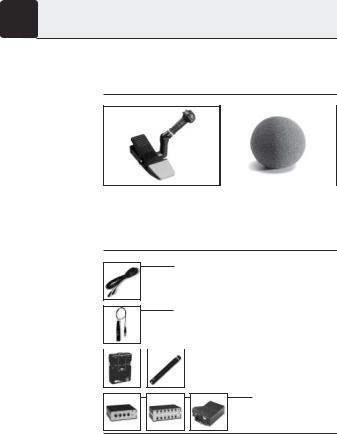
1.1 Precaution Please make sure that the piece of equipment your microphone will be connected to fulfills the safety regulations in force in your country and is fitted with a ground lead.
1.2 Unpacking
1 C 418III |
1 W 44 |
1.3 Optional
Accessories
1.4 Features
Check that the packaging contains all of the components listed above. Should anything be missing, please contact your AKG dealer.
•MK 9/10 microphone cable: 10-m (30-ft.) 2-conductor shielded cable
w/male and female XLR connectors
• MPA III L phantom power adapter

 • B 29 L, B15 battery power supplies
• B 29 L, B15 battery power supplies
• N 62 E, N 66 E, B 18 phantom power suppplies
•Rugged condenser microphone for instrument miking on stage.
•Frequency response tailored to drum miking.
•Rubber coated clamp for secure attachment to the instrument.
12

1 Description 

•Microphone arm with swivel joint for precise alignment.
•Transducer shock mount reduces handling and cable noise.
•Frequency-independent hypercardioid polar response for high gain before feedback.
The C 418III is a miniature hypercardioid condens- |
1.5 Brief |
|
er microphone. It has been specifically designed |
Description |
|
for miking up drums (snare drum, tom-toms, roto |
|
|
toms) directly on the instrument. |
|
|
A bass rolloff below 500 Hz prevents the kind of |
|
|
low-frequency overemphasis that would be the |
|
|
natural consequence of placing a microphone ex- |
|
|
tremely close to the top head of a drum. A boost in |
|
|
the microphone's sensitivity between 5 kHz and |
|
|
10 kHz provides a punchy sound. |
|
|
A solid, rubber coated clamp will fix the micro- |
|
|
phone securely on the instrument and the swivel |
|
|
joint on the microphone arm allows you to align |
|
|
the microphone exactly with the desired "sweet |
|
|
spot" on the skin. |
|
|
The microphone's frequency-independent hyper- |
|
|
cardioid polar pattern ensures high gain before |
|
|
feedback and reduces spillover from neighboring |
|
|
instruments to a minimum. The transducer is sus- |
|
|
pended in a special shock mount that makes the |
|
|
microphone highly insensitive to mechanical noise |
|
|
and drumstick blows. |
|
|
An external windscreen supplied with the micro- |
|
|
phone helps reduce wind noise when using the |
|
|
microphone on an open-air stage. |
|
|
|
|
|
The C 418III is available in two versions: |
1.6 Versions |
|
• With 3-pin XLR connector with integrated ad- |
C 418III PP: |
|
apter for 9 to 52 V universal phantom power. |
|
|
• With locking mini XLR connector for use with |
C 418III L: |
|
the B 29 L battery power supply, MPA III L |
|
|
13
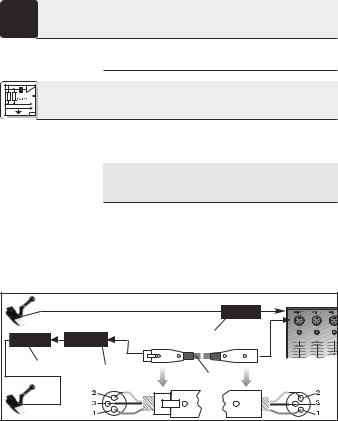
phantom power adapter, or AKG bodypack transmitters.
2.1 Introduction The C 418III is a condenser microphone and therefore needs a power supply.
Important! Using any power supply other than those recommended by AKG may damage your microphone and will void the warranty.
2.2C 418III PP 1. Connect the phantom power adapter (1) on the
2.2.1Connecting microphone cable to a balanced XLR micro- to Balanced phone input with phantom power.
Inputs 2. Switch the phantom power on. (Refer to the in-
Refer to fig. 1. struction manual of the unit to which you connected your microphone.)
|
|
XLR |
XLR |
Phantom |
1 |
1 |
2 |
|
|
3 |
|
|
|
Fig. 1: Connecting to a balanced input.
Refer to fig. 1. 3. If your mixer provides no phantom power:
Connect the phantom power adapter (1) to an optional AKG phantom power supply (2) (N 62 E, N 66 E, B 18, B 15) and use an XLR cable (3) (e.g., an optional MK 9/10 from AKG) to connect
14
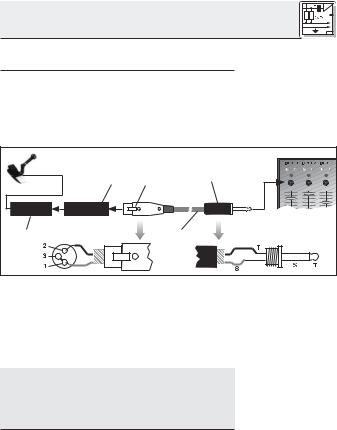
2 Interfacing |
the phantom power supply to the desired balanced input.
You may connect any AKG phantom power sup- |
2.2.2 Connecting |
ply (2) to an unbalanced input, too. |
to Unbalanced |
|
Inputs |
Use a cable (3) with a female XLR connector and |
Refer to fig. 2. |
TS jack plug: |
|
|
2 |
4 |
5 |
XLR |
Phantom |
|
|
1 |
|
|
3 |
Fig. 2: Connecting to an unbalanced input.
1.On the XLR connector (4), use a wire bridge to connect pin 1 to pin 3 and the cable shield.
2.Connect the inside wire of the cable to pin 2 on the XLR connector (4) and the tip contact of the jack plug (5).
Unbalanced cables may pick up interference Note: from stray magnetic fields near power or lighting
cables, electric motors, etc. like an antenna. This may introduce hum or similar noise when you use a cable that is longer than 16 feet (5 m).
The optional B 29 L battery supply allows you to |
2.3 C 418III L |
connect the microphone to balanced or un- |
2.3.1 Using the |
balanced inputs with no phantom power. |
Optional B 29 L |
15
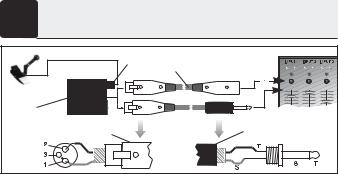
|
1 |
3 |
|
|
|
B 29 L |
|
|
2 |
|
|
4 |
|
5 |
|
|
Fig. 3: Using the B 29 L to power the microphone.
Connecting the 1. Push the mini XLR connector (1) on the micro- cable: phone cable into one of the two mini XLR
Refer to fig. 3. sockets on the B 29 L (2) to the stop. The connector will lock automatically.
Disconnecting To disconnect the cable, press the unlocking the cable: button on the mini XLR connector (1) and pull
the connector (1) out of the socket.
Important! |
To avoid damaging the cable, never try to |
|
pull out the cable itself! |
Refer to fig. 3. |
2. Connect the B 29 L (2) to the desired input. |
Balanced input: |
• Use a commercial XLR cable (3) to connect |
|
the B 29 L (2) to a balanced input. |
Unbalanced input: |
• Refer to section 2.2.2 above. |
2.3.2 Using the 1. Push the mini XLR connector (1) on the micro- MPA III L phone cable into the mini XLR socket (2) on the
Connecting the cable: cable of the MPA III L (3) to the stop. Refer to fig. 4. The connector will lock automatically.
Disconnecting
the cable: Refer to section 2.3.1 above.
16
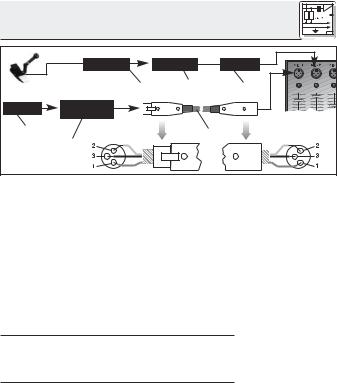
2 Interfacing |
|
Mini XLR |
Mini XLR |
MPA |
|
1 |
2 |
3 |
MPA |
Phantom |
|
|
3 |
4 |
|
5 |
|
|
|
Fig. 4: Connection diagram with MPA III L.
2.Connect the MPA III L (3) to a balanced XLR microphone input with phantom power.
3.Switch the phantom power on. (Refer to the instruction manual of the unit to which you connected your microphone.)
4.If your mixer provides no phantom power: Refer to fig. 4. Connect the MPA III L (3) to an optional AKG
phantom power supply (4) (N 62 E, N 66 E, B 18, B 15) and use an XLR cable (5) (e.g., an optional MK 9/10 from AKG) to connect the phantom power supply (4) to the desired balanced input.
Refer to the manual of your bodypack transmitter. 2.3.3 Connecting to a Bodypack Transmitter
17
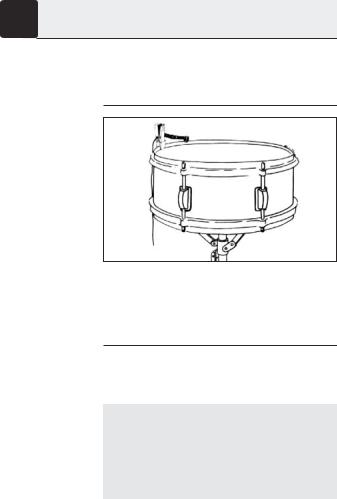
3.1 Introduction The best way to get the ultimate sound is to experiment with various microphone positions. The following sections describe proven techniques that you may want to use as starting points for your own experiments.
3.2 Snare Drum
Fig. 5: Fixing the microphone on a snare drum.
Refer to fig. 5. 1. Clamp the microphone to the top hoop.
2.Align the microphone:
•To get a tight, punchy sound, aim the microphone at the perimeter of the skin.
•To get a rounder, more open sound, aim the microphone at the center of the skin.
3.3Tom-toms, 1. Clamp the microphone to the top hoop and Roto Toms align the microphone referring to section 3.2
Refer to figs. 6 and 7. |
above. |
Note: The frequency response of the microphone has been specifically designed to roll off gently below 500 Hz down to a maximum attenuation of 12 dB at 50 Hz. This will largely prevent top head ringing from becoming audible. To get a very dry sound, you can tape a strip of felt or a piece of tissue paper to the skin in an offcenter position.
18
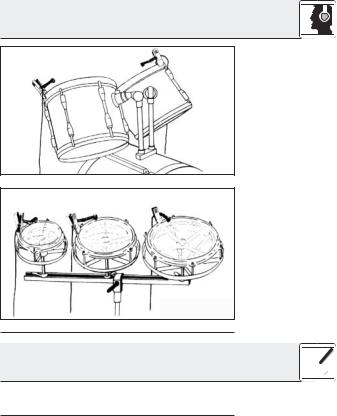
3 Using Your Microphone 

Fig. 6: Fixing the microphone on tom-toms.
Fig. 7: Fixing the microphone on Roto toms.
4 Cleaning 

To clean the microphone case, use a soft cloth moistened with water.
19

|
|
|
|
|
|
|
|
|
|
|
|
Problem |
Possible Cause |
|
Remedy |
||
|
|
|
|
|
|
|
No sound: |
1. |
Power to mixer |
1. |
Switch power to |
|
|
|
and/or amplifier is |
|
mixer or amplifier |
|
|
|
off. |
|
on. |
|
|
2. |
Channel or master |
2. |
Set channel or |
|
|
|
fader on mixer, or |
|
master fader on |
|
|
|
volume control on |
|
mixer or volume |
|
|
|
amplifier is at zero. |
|
control on ampli- |
|
|
|
|
|
fier to desired |
|
|
|
|
|
level. |
|
|
3. |
Microphone is not |
3. |
Connect micro- |
|
|
|
connected to mix- |
|
phone to mixer or |
|
|
|
er or amplifier. |
|
amplifier. |
|
|
4. |
Cable connectors |
4. |
Check cable |
|
|
|
are seated loosely. |
|
connectors for se- |
|
|
|
|
|
cure seat. |
|
|
5. |
Cable is defective. |
5. |
Check cable and re- |
|
|
|
|
|
place if damaged. |
|
|
6. |
No supply voltage. |
6. Switch phantom |
|
|
|
|
|
|
power on. |
|
|
|
|
|
Phantom power |
|
|
|
|
|
supply: connect to |
|
|
|
|
|
power outlet or in- |
|
|
|
|
|
sert battery |
|
|
|
|
|
(batteries). |
|
|
|
|
|
Check cable and re- |
|
|
|
|
|
place if necessary. |
|
|
|
|
|
|
|
Distortion: |
1. |
Gain control on |
1. |
Turn gain control |
|
|
|
the mixer set too |
|
down CCW. |
|
|
|
high. |
|
|
|
|
2. |
Mixer input sensi- |
2. Connect a 10-dB |
|
|
|
|
tivity too high. |
|
preattenuation |
|
|
|
|
|
pad between |
|
|
|
|
|
microphone cable |
|
|
|
|
|
and input. |
|
|
|
|
|
|
20
